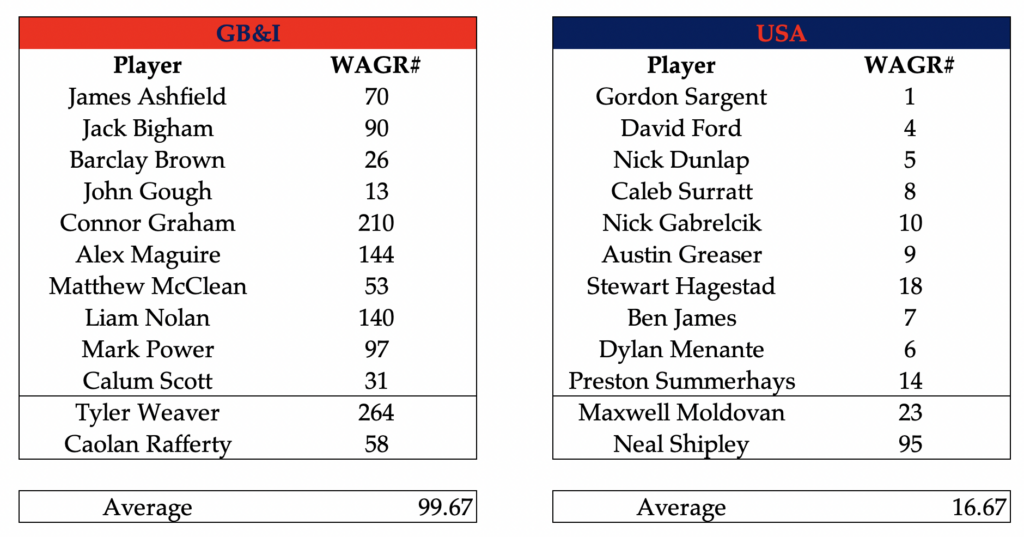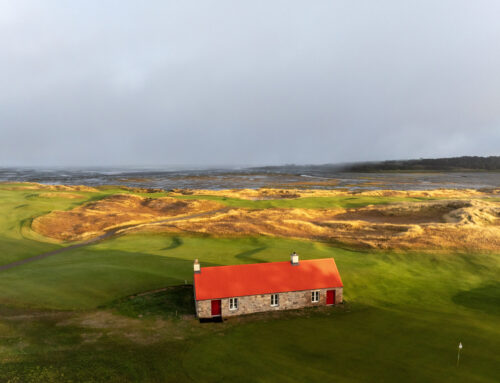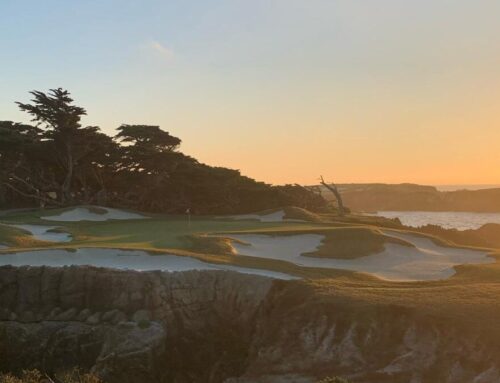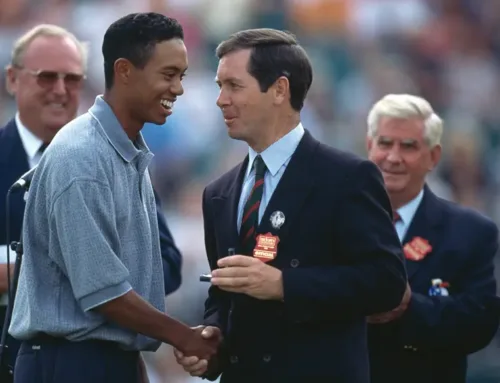
Team Great Britain and Ireland and Team USA pose for a photograph during a putting contest at the Himalayas – (Photo by Ross Parker/R&A/R&A via Getty Images)
As anticipation builds and with just four days until the opening tee shot at the 49th Walker Cup, taking place 100 years since the first staging, it’s worth taking a brief moment to reflect on the last transatlantic battle that took place at Seminole in May 2021.
The build-up to Seminole lingers in the memory for a rather peculiar reason; Florida played host to the Walker Cup during the remnants of the COVID golf era, marked by woggles in holes and foot raking in bunkers. So, when the GB&I team crossed the pond, they were still completing daily screenings for the virus.
When a number of players from both sides took ill just a couple of days before play, confusion abounded with all testing negative for Covid. The precipitant was most likely a dodgy dessert at The Breakers Hotel in Palm Beach. With the players all rooming in close proximity, they never stood a chance against a stomach bug. Just a day before play was scheduled to start, 10 of the 24 players and both Captains were unfit to travel to practise at Seminole. The reserves, being used for the first time in case of COVID complications had to come to the rescue. Mac Meissner (USA) and Jake Bolton (GB&I) were both called up to play in Day 1’s Foursomes. Both players secured victories for their teams.
Surprisingly, it was the first time a Walker Cup had been hosted in Florida. Barring the ‘Driving Relief’ match between Rory McIlroy et al, it was the first look at Seminole for many, a club that has traditionally prioritised its privacy. A club with 330 members and 200 of those with a single digit handicap is a perfect representation of George Herbert Walker’s event. Indeed, 10 of the Walker Cup’s 30 Captains have been Seminole members.
The Donald Ross designed (1929) was perhaps a venue that lent itself more to the eye of the British and Irish players. A relatively flat, firm and fast seaside property, with the wind being its principal defence, definitely gave the away side some extra encouragement. The event was played in May to conform to Seminoles season and also when it would be best presented; the club is closed during the summer.
A slack wind on the morning of Day 1 saw the Irish duo of Mark Power and John Murphy beat Quade Cummins and Austin Eckroat while Angus Flanagan and Jake Bolton held on in breath-taking fashion to secure two early points. The Yorkshire pair of Alex Fitzpatrick and Barclay Brown were narrowly edged out by Cole Hammer and World Number 1 Davis Thompson. Jack Dyer and Matty Lamb lost to Mac Meissner and Ricky Castillo, leaving the morning session tied up at 2-2. The Americans showed their class in the afternoon session of singles, winning five matches. Barclay Brown, Mark Power and Matty Lamb were victorious to keep GB&I in touching distance. At the end of Day 1, the Americans led 7-5.
On Day 2, Stuart Wilson’s side performed valiantly. GB&I took control of the morning foursomes, with Power and Murphy continuing their fine form and Matty Lamb and Jack Dyer winning in style by 6&5 over Stewart Hagestad and Tyler Strafaci. Alex Fitzpatrick and Barclay Brown were narrowly beaten by a hole whilst the other match was halved. But the American lead had been reduced to just a single point.
In a knife-edge final session the Americans edged out GB&I by 5.5 to 4.5, which so nearly went down to the wire. Playing in the middle of the order, Joe Long, Matty Lamb and Angus Flanagan provided a burst of victories. However, with five wins on the board the home side managed to get the job done and secure victory by two points.
Day 1: USA 7-5 GB&I
Day 2: USA 7-7 GB&I
Total: USA 14-12 GB&I
Whilst the Americans were ultimately victorious, it must be stressed what a strong performance it was by the GB&I team.
Ahead of St Andrews, I have compared the two sides to outline the dominance the Americans have in the WAGR rankings.

Although it is clear the Americans come in with a clear advantage on paper, it may also be worth noting the number of events and consequently points available to those who play on the US college circuit. Players such as Liam Nolan, Connor Graham and Tyler Weaver have all not had the luxury of playing in frequent collegiate events that all carry high WAGR power rankings. Neither has Matthew McClean but he has admittedly been busy playing in The Masters and The US Open.
Connor Graham, at just 17 years of age, has already racked up WAGR points in 11 different countries. Gordon Sargent’s points, with the exception of one event in France, have all been earned in the United States. So, there is something a little unsatisfactory about WAGR as a tool for comparing these two sides.
I must refer you to a great piece Mark Eley wrote on Fred Solomon, who sadly passed away earlier this year. His Scratch Players World Amateur Ranking (SPWAR), which was widely acknowledged as the most accurate ranking system for male amateurs. You can read that here. It would be very interesting to see how the rankings differed in his system.
Nevertheless, if you take this American side at face value according to WAGR, there is no denying it has to be one of the greatest of all time. Without Neal Shipley in the side (he is rightfully included after a runner up finish at the US Am), the average WAGR ranking is under 10 (9.75).
The GB&I squad have a big task on their hands to overcome such a strong opposition, but they have experience: Barclay Brown and Mark Power bring nous from Seminole with them. Brown, McClean and Maguire also all have recent experience on golf’s biggest stage in major championships and Maguire won the St Andrew’s Links Trophy only this year.
As we all know, The Old Course without due diligence can cause Americans some hiccups. Think Bobby Jones tearing up his scorecard in the 1921 British Open on The Old Course. One thing is for sure, matchplay around the hallowed turf of this famous links is sure to be box office.

ST ANDREWS, SCOTLAND – AUGUST 28: General view of Walker Cup branding during a practice round prior to the Walker Cup at St Andrews Old Course on August 28, 2023 in St Andrews, Scotland. (Photo by Ross Parker/R&A/R&A via Getty Images)






